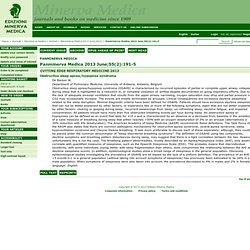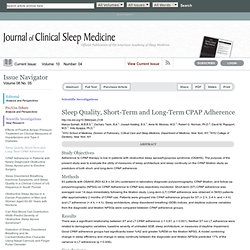

The Stop the Snore Pledge. Feeling Great Sleep Center. Q: What is CPAP therapy?

A: CPAP stands for “continuous positive airway pressure,” and it is considered to be the most recommended and effective treatment for obstructive sleep apnea (OSA). A CPAP machine provides air at a constant prescribed pressure through a tube and CPAP mask, which patients suffering from OSA to maintain uninterrupted breathing while sleeping by holding open their airways. The pressure of the air is determined during your sleep study and your doctor will prescribe you a CPAP machine at that pressure. CPAP therapy is traditionally provided through a nasal mask that seals around the nose. However, more innovative and comfortable options are available and advances in the delivery of CPAP therapy are continually occurring. Q: What does the term, “humidification” mean in reference to CPAP therapy? A: Humidification, refers to the process of adding humidity, or moisture, to the CPAP air, which reduces nasal passage irritation – and sometimes, bleeding – due to dryness.
LISA® - Leading Independent Sleep Aide. Living with CPAP - Sleep Apnea. Using Continuous Positive Airway Pressure to Treat Sleep Apnea If you use continuous positive airway pressure (CPAP) to treat obstructive sleep apnea (OSA), you likely have a love-hate relationship with the device.

On the one hand, you know that OSA is a serious condition with real health risks, and you probably feel better during the day when you use the device. On the other hand, you're forced to sleep all night wearing a mask attached to a hose and air machine. This setup can be uncomfortable and unwieldy for you—and awkward and disruptive for your bed partner—so it's understandable why you might resist using it. But you ignore the device at your own peril: Left untreated, OSA puts you at increased risk for daytime drowsiness, impaired mental performance, and cardiovascular problems such as high blood pressure, irregular heart rhythms and stroke. Use CPAP Consistently A solid body of research indicates that CPAP works. Overcoming Obstacles To CPAP Compliance You got off to a bad start. STOP, THAT and One Hundred Other Sleep Scales. Obstructive sleep apnea/hypopnea syndrome - Panminerva Medica 2013 June;55(2):191-5 - Minerva Medica - Journals.
Obstructive sleep apnea/hypopnea syndrome De Backer W.

Department of Pulmonary Medicine, University of Antwerp, Antwerp, Belgium Obstructive sleep apnea/hypopnea syndrome (OSAHS) is characterized by recurrent episodes of partial or complete upper airway collapse during sleep that is highlighted by a reduction in, or complete cessation of, airflow despite documented on going inspiratory efforts. Due to the lack of adequate alveolar ventilation that results from the upper airway narrowing, oxygen saturation may drop and partial pressure of CO2 may occasionally increase.
The events are mostly terminated by arousals. Language: English top of page. CPAP Training Video Part 2. CPAP Training Video part 1. An Introduction to CPAP. JCSM - Sleep Quality, Short-Term and Long-Term CPAP Adherence. Manya Somiah, M.B.B.S.1; Zachary Taxin, B.A.1; Joseph Keating, B.S.1; Anne M.

Mooney, M.D.1; Robert G. Norman, Ph.D.2; David M. Rapoport, M.D.1; Indu Ayappa, Ph.D.1 1NYU School of Medicine, Division of Pulmonary, Critical Care and Sleep Medicine, Department of Medicine, New York, NY; 2NYU College of Dentistry, New York, NY Untreated obstructive sleep apnea/hypopnea syndrome (OSAHS) significantly affects quality of life and cardiovascular/cerebrovascular morbidities and mortality.1–4 CPAP therapy has been shown to be effective in treating sleep disordered breathing (SDB) by reducing the apnea/hypopnea index (AHI)5 and by reducing excessive daytime somnolence (EDS).6 Despite this, CPAP acceptance and adherence are disappointingly low.
The purpose of the present study was to evaluate the utility of measures of sleep architecture and continuity on the CPAP titration study as predictors of both short-term and long-term CPAP adherence. Protocol Summary Flow chart of study protocol Procedures. JCSM - Investigating Reasons for CPAP Adherence in Adolescents: A Qualitative Approach. Scientific Investigations Investigating Reasons for CPAP Adherence in Adolescents: A Qualitative Approach.

JCSM - Investigating Reasons for CPAP Adherence in Adolescents: A Qualitative Approach.